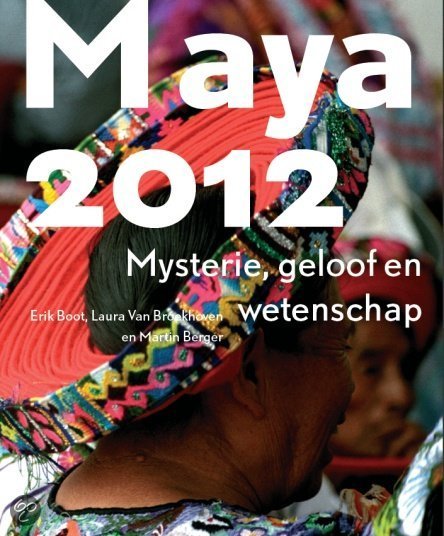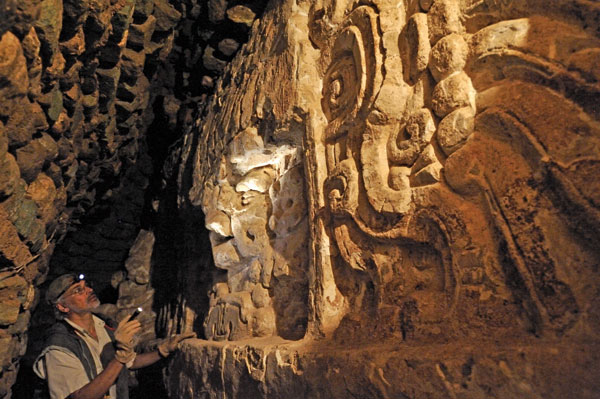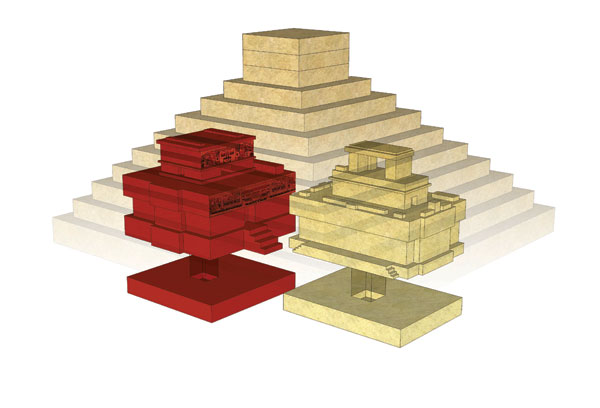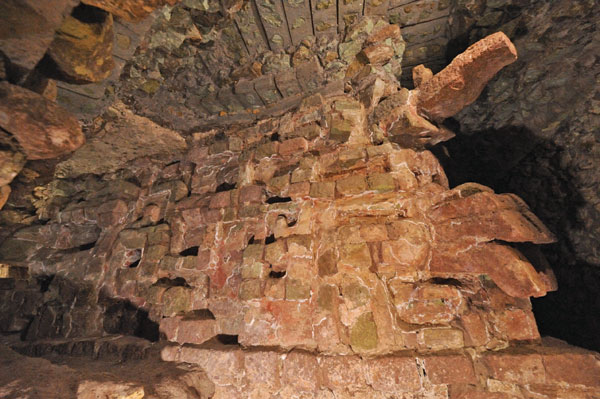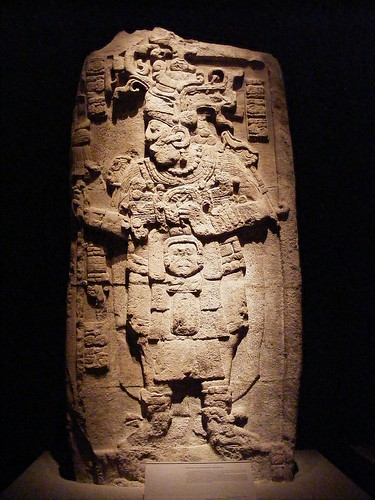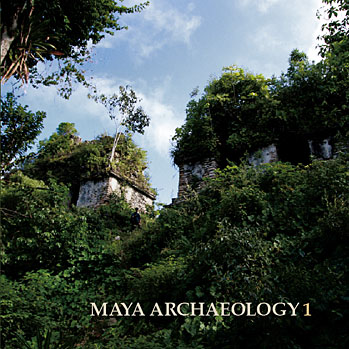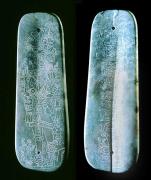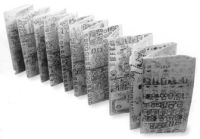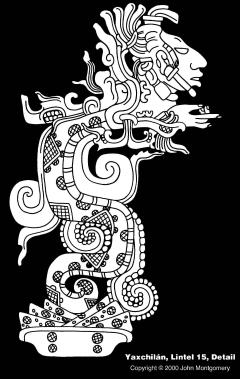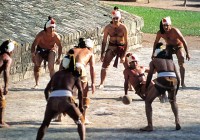"The Carrier of the Ancestor of Tak'alik Ab'aj ": Monuments 215 and 217 - The archaeological excavations of the National Project Tak'alik Ab'aj have produced a stream of discoveries of very important sculptures this year. It began on March 10, 2008 with the Altar 48, the Monument to the birth of the Mayan culture. On June 25 appeared the Monument 215, it forms part of the basement wall on the east side of the Structure 7A. As excavations work continued along the wall the Monument 217 was discovered on the 26th of August 2008. Both sculptures of Monument 215 and 217 had been mutilated and were integrated as constructive elements in this wall. However, it was possible to verify that the two sculptures have been linked, forming a single monumental sculpture carved on all four sides.
This sculpture presents an imposing character, decorated with insignias of power with certain Olmec characteristics such as the sign U on the sash. Something very surprising is that this character is carrying a small human figure on his back. This small human figure has the position of his arms on his chest and hands folded down, and very straight legs, similar to those infants who are often found in the lap of the Olmec jade figures. These infant figures have been interpreted by some archaeologists as divine beings or ancestors. The quality of the volume and complete form of the sculpture conveys the formal concepts of Olmec art sculpture; however, this sculpture seems strange.
The character is standing on the capital of a column of rectangular sides. The capital was carved in the shape of the head of a monster bat or monster of the earth (Cauac). This form of representation of the monster Cauac with Mayan features is found a few decades later in other classic Maya cities, as in Quirigua and Copan. In Quirigua and Copan the steles have the monster Cauac on the base on which the rulers are standing. It is important to note that the small figure on the back of the standing character is literally joined by an extended cloth or skirt to the head of the bat. It is evident that the intention of the sculptor of this figure was to communicate the importance of the union of the carrier of the ancestor with the monster of the earth.
The rectangular column that carries the capital of the monster bat was mutilated and cut of near the start of the head of the bat. Surprisingly, two pieces of sculptures found in excavations years ago that had been saved, fit into the column. Because these two pieces complete the column, now it is possible to see that on the frontal face of the column a character was sculpted in low relieve. In low relieve and in profile this character shows definite characteristics and the distinct style of Mayan sculpture. This character is decorated with lavish garments and its face emerges from an elaborate headdress mask, similar to the two figures carved on the two sides of the Stela 5 Tak'alik Ab'aj. On both sides of the column text can be found in a double column of early glyphs. The meaning of these early glyphs is still being ardently discussed by Mayan scholars who specialize in glyphs all over the world.
There are many questions that arise around this monumental sculpture:
=Why is the character carrying a small figure on his back?
=Who is the character and who is the little creature?
=Why is this character standing on a bat?
=Why is the sculptural style of the character apparently different from that of the style of the bat?
=What is the message that the sculpture is transmitting? What is the message transmitted by the two texts in early glyphs?
=Why was this sculpture destroyed and its pieces then included in the structure of the wall?
=Where had this sculpture have been standing so it could be seen from all four sides?
It is known that the fragments of this enigmatic sculptures were placed into the buildings during the second part of the Late Pre- Classic Period (Phase Ruth 200 BC - 150 AD), which is when the early Mayan culture was florishing. Therefore this sculpture must have been carved before this time. There are two possibilities, it was carved at the start of the early Mayan era, or a little earlier, when the changes in Tak'alik Ab'aj from the Olmec era to the Mayan era was taking place, what is called the transition period. Could it be that the early Mayan sculptor wanted to invoke the preceding Olmec culture as ancestors, as it later appears in the Mayan steles, where the ancestors are depicted watching from the heavens to protect and legitimize the power of the ruler represented below?
The sculpture of the Carrier of the Ancestor of Tak'alik Ab'aj is an unprecedented finding. The monument is unique and represents a great challenge for archaeologists. According to the latest opinions of the world's most famous Mayan archaeology experts, there is so much about the Mayan civilization that is not yet known, so many archaeological sites that are yet to be excavated and studied, that they predict that the classic concepts about Mayan history will change dramatically over the next 20 years. In Guatemala alone, most of the archaeological sites that are considered Mayan have not yet been excavated. Vast geographical areas full of Mayan cities and monuments are still covered by earth and jungle.
We think that this is actually good news. In the past looting and ransacking of unprotected archaeological sites in remote areas presented a serious problem, a heavy loss to the cultural heritage of Guatemala. Maybe now, with more responsible archaeological institutions and a new perspective of Archaeology, the undiscovered sites present a unique opportunity to preserve the cultural heritage of Guatemala and make new exiting discoveries about the ancient Mayas and their mysteries (written by Bosse Persson; for the complete illustrated report, see source The Guatemala Times).
A note from the editor: This early statue carries an anthropomorphic figure on its back. In Central America there are several stone statues of human beings that carry a variety of animal figures on their shoulders and back (e.g. basalt statue of an upright human being carrying a jaguar, from Punta del Sapote, Isla Zapatera, Lago de Nicaragua). These particular statues date from of period of circa A.D. 800-1200. The Tak'alik Ab'aj example may be a Late Preclassic antecedent to a yet unknown cultural phenomenon that was expressed by carrying animal figures on back and shoulders in the Terminal to Postclassic period in Central America. Last year (June 13-15, 2007), at the seminar "The Chibchan Area" (Leiden University, the Netherlands) a tentative link was suggested with the krun ceremony among the Ngawbe (Guaymi) of Panama, in which participants carry animals on their back (if I remember this correctly, as I have yet to find my notes ...).
Full text of the original article now available. Note that the online article at The Guatemala Times has additional illustrations of the monument.





